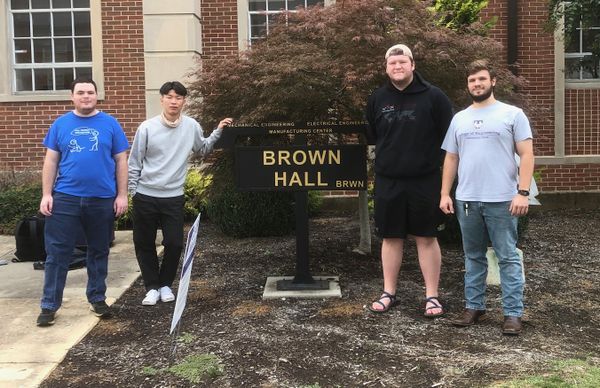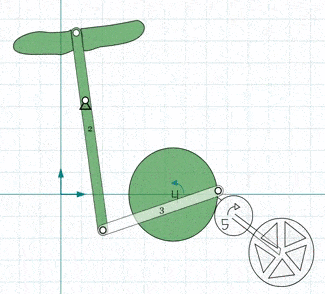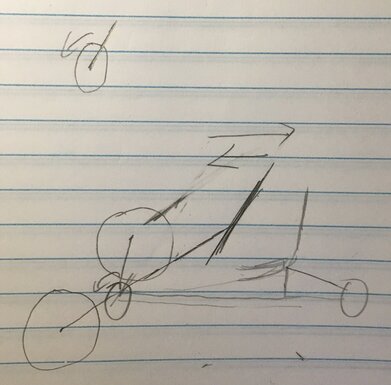Novel Bike
Abstract
Abstract here - a short statement of the need, findings of project and project outcome.
Team members
Team Photo:
The team
- From L-R: Matthew Turner, Yixing Wang, George Huttick, Austin Downing
Acknowledge help of others
- Advisor: Dr. Canfield
- Therapist: Ms. Melissa Draper
Problem Statement/overview of the need
Summary of the project need
- Our team seeks to design an upper body/arm controlled bike that is lightweight, maneuverable, safe, and fun for the students riding the bike. The bike will use no chains, belts, or anything that could act as a pinch point and harm the students riding the bike. In order to fit through doorways, the bike must be less than 36 inches wide. To accommodate a variety of students riding the bike, children from 40-52 inches tall must be able to fit on, and operate, the bike comfortably. Steering should be very minimal and will primarily be used for veering out of the way of people or objects. The braking system on the bicycle should be able to bring the rider to a stop quickly without causing the bicycle to tip over, or become unstable. Overall, simplicity of operation, maneuverability for Ms. Draper, safety, and the fun factor are key design elements that we seek to provide in this bicycle redesign.
Design Specifications
Design Specifications:
- Ease of maneuverability
- Fun
- Easy to operate
- Adjustable to fit children of varying height (40"-52")
- 36" wide (MAX)
- Lightweight
- SAFE (No pinch points, no sharp edges)
- The bike needs to be designed to be fun, easy to operate, and easily maneuverable. This is because the students that will receive the bike have special needs, and many of them will refuse to use it if they don’t like it. The bike is also being designed to fit students ranging from 40" to 52". The bike needs to be able to fit through doorways, so it can be ridden in hallways. As well as, the bike needs to be light for someone to pick up in case a kid gets stuck and someone needs to help them turn around. The design also needed to be focused around safety minimizing pinch points and reducing sharp edges. The bike also needs to include a lockout steering mechanism and the vehicle needs to move forward when the pump is actuated in both directions.
Background research
1. What exists already, similar products 2. availability 3. identify gaps in existing products or technology to be addressed
Our team was able to find similar designs on the market already. The closest available product to what our current design thoughts are, comes from a German company known as Hase Bikes.
https://hasebikes.com/104-1-Special-Needs-Trike-Handbike.html#
Their bike has many similar features to what our group is considering with our design. The company is known for their quality of product and the price shows, the base model for their hand powered accessibility bike starts around 6500 euros (approximately $7500 here in the US). They have local certified vendors in America the closest being in Newport, TN.
The challenges faced in the existing product vs our preliminary designs largely goes to price and lack of flexibility in usage of the bike. The bikes produced by Hase are designed for specific height/length of a person. As our design is intended to be used by multiple children, we must incorporate a way for the bike to comfortably fit them. Additionally, we need to make the bike more cost affordable while still maintaining a sense of high quality.
Other possible products include a very large variety of handbikes that follow the design we are considering, most of these however are designed for handbike racing and therefore have very low center of gravity points. We believe the challenge here is that many of the children this bike intends to help, will not be able to sit in a bike that is a mere 4-6 inches off of the ground and then return to whatever their situation may be. (i.e. moving from a wheelchair to the bike and back would prove to be a large distance to cover) This encourages us to make the height of the seat accessible to whatever the child's situation is.
In the case of a linear motion design there are a few things we can reference that we found:
Firstly, there is a man who designed a bike off of a linear movement of his arm, similar to how steam engine locomotives function, this could be adapted to fit our needs as well. He provides a lot of the design work he put into his specific bike and explains the motion and design well.
https://lefthandedcyclist.blogspot.com/2014/07/graeme-obrees-beastie-lure-of-linear.html
Additonally, if we follow a pump design. We have other products that we can reference to help us understand the movement we are trying to replicate. The best example of this being a Handcar which was designed to be powered by a person or people and rode on the train tracks. We can use the concepts of motion that the handcar exhibits to produce a similar motion within a hand pump style bicycle. The following is a link to a website that shows a replica that was built of a handcar, and shows a video of it in motion as well.
https://cavanandleitrim.wixsite.com/home/post/pump-trolly
Conceptual Design
- The design concept for this bike is front wheel drive, 3 wheels bike with two wheels parallel at the front and one wheel at the back behind the seat to reduce body weight and reduce the overall length to make it easier to ride and turn, and it has adjustable bar between to seat and front wheel because it designed to use for multiple kids, thus we want to make it perfect fit for everyone.With low sitting position to make it safer and fun combine with hand pedal power train instead of feet pedal.
Design Concept 1
Summary:
- Concept one uses the design aspects seen in engines and how the pistons move. Turning a linear input motion into a rotational output. This design should allow for movement of the bike through no chains, only a direct connection to the main wheel driving the bike. Making the entire mechanism on a single wheel is preferred as it would allow for it to be easily mounted in a way that allows turning still. The design can be adapted for a different angle of motion by moving the linkages so the push/pull motion is comfortable and intuitive from the seat. Additionally, the linear adaptation can possibly be made without the linkages, but housing to keep the movement linear would need to be created and mounted properly. Should the customer raise question on the pinch points in this design, the best solution would be housing that fully covers the location where pinching can occur.
- MotionGen Simulation of Design Concept 1:
- A video reference to the mechanism utilized in Design Concept 1: https://youtu.be/oWurtn2B7xo (Linear adaptation of design)
Design Concept 2
Summary:
- Design Concept 2 is very similar to the bike Ms. Draper received last semester(SP-19). The main difference between this concept and the original is the lack of a chain to drive the wheels. Instead, a bar attached to a large gear would drive a smaller gear that is rigidly connected to the rear wheels. This design lacks any form of steering and relies on being rotated by hand once stopped. This can be achieved by lifting up the front of the bike and rotating it 180°. One of the major downsides to this design is the motion required to drive it. Children riding the bike need to push the handle all the way forward and backwards. However, they may be inpatient and only push the handle halfway. The best solution using this design would be to limit the necessary distance that the handle needs to be pumped. This would, of course, make the bike harder to accelerate.
- MotionGen Simulation of Design Concept 2:
Design Concept 3
Summary:
- This a 3 wheel pump and go bike, with two wheels on the front or back, its interchangeable, or one wheel on the back or front, respectively. The motion for this bike is provided by a bar that can be pushed from the children's setting position. The bike moves forward no matter the bar is pushing forward or pulling backward. The material I am considering for this bike would be mainly plastic since it is designed for younger kids with spatial awareness problem, specially height range from 40 inches to 50 inches kids. The turning for this design is going to be very minimal since it doesn't have steer wheel. But it can still turns in small angle from the feet stand.
Hand Drawn Design Concept 3:
Evaluate concepts/select candidate
Use a decision matrix or similar tool to compare designs against project specifications Discuss winning candidate
Detailed Design
This section will describe a detailed design process
Description of selected design
Detailed description of selected design
Analysis
Describe three types of analysis to be performed on the design
Engineering analysis 1
Engineering analysis 2
Engineering analysis 3
CAD Drawings
Insert drawings of all parts and the assembly
Bill of Materials
qty, item, description, source, part number, price
Assembly Instructions
Fabrication Process
Insert pictures of fabrication process
Testing and implementation
Describe testing, delivery, how used/received by the family
Photos of Completed design
Insert pictures of the final product
Instructions for safe use
Provide a clear summary of safe use for the family. Do not use the device unless supervised by an adult that has been fully understood the safe use of this product.

.gif)

